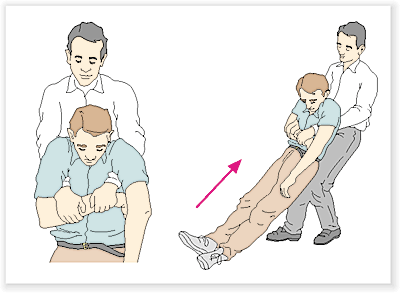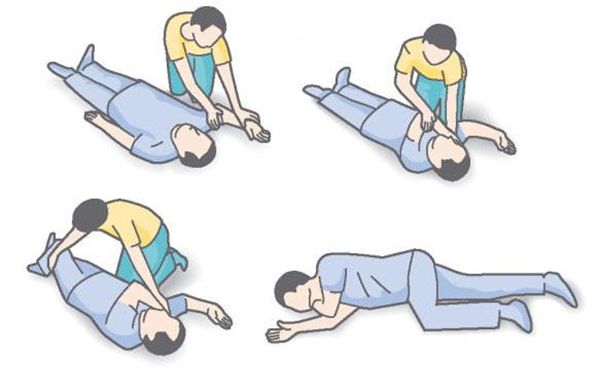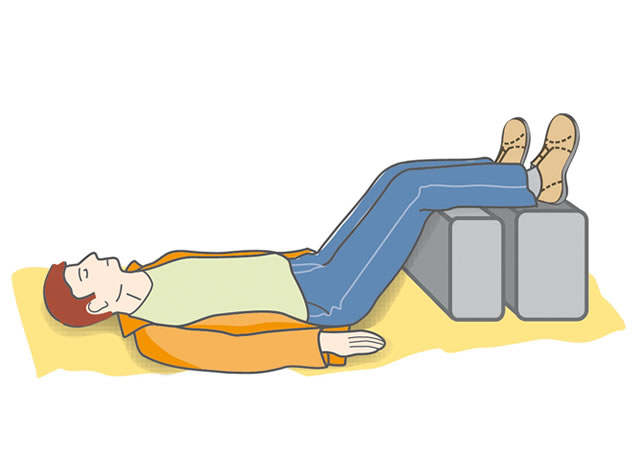MedicalMonday #4: When seconds count – First Aid TEST YOURSELF [Engl/Ger]
health·@co-co·
0.000 HBDMedicalMonday #4: When seconds count – First Aid TEST YOURSELF [Engl/Ger]
# Life saver or bystander - you decide!
deutsche Version siehe unten
<div class=pull-right>https://steemitimages.com/DQmdVLLSTphK3BaGpxAQmNBBVpHzxtkH9n8xJGgZEZV5NwY/D4564.png.</div>Car accident, heart attack, stroke - would you know what to do?
The first minutes after such an event are often deciding over life and death! Even more important is the ability of the first aider to realize what is going on and to react correctly. Each of us is responsible for being prepared for emergency as good as possible and to refresh this knowledge regularly.
Would you know the first symptoms of a stroke or heart attack? How was the right procedure during a cardiac arrest again?
Often it's just seconds that can change everything - if you know how to use them correctly, is up to you!
# Test yourself
In the following, I made up a few common emergency-szenarios and prepared them so that you can check if you would react correctly. Every case starts with a short description of this situation.
Read carefully and think about what you would do before (!) scrolling down. Afterwards I listed in a short and memorable way the standard procedure everybody should know. Take your time to think these scenarios through and refresh your knowledge - you never know if it could help you save someone's life maybe already tomorrow!
## Case 1
You are the first vehicle that arrives at the scene of an accident. Car vs motorcycle - the driver of the motorcycle is lying injured in the middle of the road, the car driver motionless in his car. How do you react?

### Car accident
1. **Securing of the danger area**
The first thing to do, is to make sure, the danger area is marked. This is an often forgotten step, that can lead to following accidents, so keep it in mind. There should always be a warning triangle and west in your car.
An optimal safety distance for putting up the secure triangle would be:
Highway: 250 meters
Road: 150 meters
City: 50 meters
*Important: Ensure your own safety. If there is danger of an explosion, fire, poisoning etc, stay away and call a specialized emergency team!*
2. **Emergency call**
Important information:
WHERE is the emergency
WHAT happened
HOW MANY are affected
WHO is calling
3. **Rescue**
From the street/ out of the car with the Rautek-Grip:

[Quelle](http://www.elsevier-data.de/rochelexikon5a/pics/p32552.000-1.html)
If the victim is lying on his or her front: Place the head on the Upperarm and pull their hands.
Helmet-taking:
-Open the visor
-Check breathing and consciousness
-Open the chin strap
-Stabalise the neck
-Tilt the helmet till you can see the nose under the chin strap
-Remove the helmet carefully and slowly
*Many people are afraid to hurt the spine and therefor don't dare to remove the helmet. This risk must be taken. The helmet has to be removed to make a first aid provision possible. Nevertheless, pay attention to the stabilization of the neck!*
The car driver is breathing evenly and you can feel a normal pulse. He is not reacting to touch stimulation like pinching or shouting. Also after screaming at him, he does not open his eyes. Exept for some grazes, you can't see gross injuries. What will you do next?

### Unconsciousness
Recovery position
-Place the arm nearest you at a right angle to their body with their hand upwards
-Bend the knee farther from you to a right angle and touch it with the other hand
-Careully pull the person onto their side by pulling on the bent knee
-Open their airway by tilting their head back and lifting their chin
*Important:Stay with the person and keep on checking if the airways are free from blood, vomit or anything else!*

[Quelle](https://erste-hilfe-emsperger.de/stabile-seitenlage/)
You can neither determine breathing (though hearing, feeling and watching of the thorax), nor can you feel the pulse of the motorcycle-driver. He does not react to any of your tries. What now?

### Cardiac arrest
Reanimation
1. Emergency call
see above
2. Defibrillator
If possible, send someone to look for a defibrillator. Many cities are already area-covering equipped. The defibrillator will tell you exactly how to proceed.
*Important: If you are alone, do not loose time and continue immediately with step 3!*
3. Chest compressions 30x
-Place the heel of one hand toward the end of the breast-bone, in the centre of the chest
-Place the other hand on the top of the first hand and interlock your fingers
-Lean over the casualty with your arms straight, pressing down vertically on the breastbone about 5 centimeters, then release the pressure fully
-Repeat 30 times in a rhythm of 100 to 120 per minute (It can help to sing the song "Staying Alive" in your head to get into this rhythm.)
*Important: Do not be afraid to press strongly! A few broken ribs are better than death!"
4. Rescue breaths 2x
-Stretch back the chin of the casualty
-Pinch the nose firmly closed
-Take a breath and blow it into their mouth sealing your lips around it
-Watch the chest rising
-Repeat
*Important: During the rescue breaths, the compressions may not be interrupted longer than 10 seconds!*
5. Repeat step 3 and 4 until the emergency doctor arrives
## Case 2
A friend of you is having an allergic reaction on the meal you are having together for lunch. His face fades, he starts breathing very fast and his hands are shaking. He looks at you wide-eyed. What do you do?

### Shock
= disproportion of available and needed blood circulation
Causes:
- Blood loss
- Allergy/ Poison
- Fluid depletion
- Infection
- Psychological trauma
Symptoms:
- Paleness
- Wet, cold skin
- Fast, soft pulse
- Psychological changes
- Shiver, nausea
Measures:
- Elimination of the cause (f.e. arrest bleeding)
- Improvement of oxygen supply (fresh air, open the window)
- Warm
- Psychological supply
- Position:

[Quelle](https://www.apotheken-umschau.de/Erste-Hilfe/Schock-8434.html)
## Case 3
A colleague complains about nausea and vomiting, as well as suddenly appearing headache. When you look accurately, you notice one labial angle hanging down a bit. You also realize that he is talking in a blurred way. What are you thinking of?

### Stroke
Symptoms:
- Suddenly appearing strong headache
- Nausea and vomiting
- Suddenly appearing paralysis (unilateral)
- Drooping labial angle
- Speech disorder
- Disturbed consciousness
Measures:
- Inform the emergency doctor immediately
*It is said: TIME IS BRAIN! The earlier the patients arrives at the hospital, where the blood circulation of the constricted vessel can be restored, the more function of the brain will survive.*
- Constantly check consciousness, breathing and heart beat
- Keep the head elevated
## Case 4
You are watching an elderly woman at the supermarket. She looks pale and in panic. When you ask, if you can help her, she tells you about nausea and a pain in her left arm and shoulder. Also breathing feels difficult. Do you have to worry?

### Heart attack
Symptoms:
- Burning/Pressure in chest, left shoulder and left arm, also upper abdomen
- Anxiety/ Fear of death
- Cold, wett, pale skin
- Shortness of breath
- Unrest, nausea
Measures:
- Emergency call
- Upload the upper abdomen
- Calm down
- No physical activity
## Case 5
You are on a trip with friends when suddenly one of them starts to behave really strange. He looks confused, complains about strong palpitations and double images. Then he also starts to shiver and can't go forward any more. You know this colleague is suffering from diabetes. How can you help him?

## Hypoglycemia
= low blood sugar
Symptoms:
- Cold sweat, shivering, shakiness
- Strong palpitations
- Coordination difficulties, double images
- Confusion, mental absence
- Seizure, coma
Measures:
Supply of sugar as soon as possible, best would be glucose or sugered soft drinks. If the concerned person already fell into a come, call the emergency doctor!
## Help!
Please upvote or share this post! If as many Steemians as possible improve their First-Aid-competence, the chance at least one of them really has to use it is pretty high. Help to share this knowledge - together we can save lives!
Thanks a lot!
Co-Co

[Quelle](https://www.shutterstock.com/video/clip-13311821-stock-footage-hands-holding-up-thank-you-on-white-background.html)
Sources:
- 2015 American Heart Association and American Red Cross Guidelines Update for First Aid http://circ.ahajournals.org.ez.srv.meduniwien.ac.at/content/132/18_suppl_2/S574
- https://www.erc.edu
- European Resuscitation Council Guidelines for Resuscitation 2015 Section 2. Adult basic life support and automated external defibrillation; Gavin D. Perkinsa,b,∗, Anthony J. Handleyc, Rudolph W. Kosterd, Maaret Castréne, Michael A. Smytha,f, Theresa Olasveengeng, Koenraad G. Monsieursh,i, Violetta Raffayj, Jan-Thorsten Gräsnerk, Volker Wenzell, Giuseppe Ristagnom, Jasmeet Soarn, on behalf of the Adult basic life support and automated external defibrillation section Collaborators1; Elsevier, 2015
- https://www.roteskreuz.at/site/erste-hilfe/erste-hilfe-im-detail/erste-hilfe-tipps/stabile-seitenlage/
- Erste Hilfe Praktikumsunterlagen Medizinische Universität Wien; Unter Verwendung von MaterialienEuropean Resuscitation Council American Heart Association Österreichisches Rotes Kreuz Die Johanniter Medtronic Physio Control
-------------------------------------------------------------------------------------------------------------------------------------------------------------------
Deutsche Version:
# Lebensretter oder hilfloser Zuschauer - du entscheidest!
<div class=pull-right>https://steemitimages.com/DQmdVLLSTphK3BaGpxAQmNBBVpHzxtkH9n8xJGgZEZV5NwY/D4564.png.</div>Autounfall, Herzinfarkt, Schlaganfall - wüsstest du was zu tun ist?
Die ersten Minuten nach einem solchen Ereignis sind sehr oft lebensentscheidend! Umso wichtiger ist es, als Ersthelfer in so einer Situation zu erkennen, was geschieht und richtig zu reagieren. Jeder von uns trägt die Verantwortung dafür, in Notfällen so gut wie möglich vorbereitet zu sein und sein Wissen diesbezüglich regelmäßig aufzufrischen.
Wüsstest du die ersten Anzeichen eines Schlaganfalls oder Herzinfarkts? Wie war noch einmal die richtige Vorgehensweise bei einem Herz-Kreislaufstillstand?
Oft zählen Sekunden - und ob du diese richtig zu nutzen weißt, liegt in deiner Hand!
## Teste dein Wissen
Im Folgenden, habe ich häufige Notfall-Szenarien zusammengefasst und so aufgearbeitet, dass ihr überprüfen könnt, ob ihr in der Situation richtig handeln würdet. Jeder Fall beginnt mit einer kurzen Beschreibung der Situation.
Lies diese konzentriert durch und überlege, ob du weißt was zu tun wäre bevor (!) du weiter scrollst.
Sei ehrlich zu dir selbst!
Anschließend ist in kurzer, einprägsamer Weise die korrekte Vorgehensweise zusammengefasst. Nimm dir Zeit, diese Fälle aufmerksam durchzugehen und dein Wissen aufzufrischen! Man kann nie wissen, ob du damit jemandem vielleicht schon morgen das Leben retten kannst!
## Fall 1
Du kommst als erstes Fahrzeug zu einem Unfallort. Auto vs Motorrad - der Motorradfahrer liegt verletzt in der Straßenmitte, der Auto-Lenker bewegungslos im Fahrzeug. Wie reagierst du?

### Autounfall
1. **Gefahrenzone sichern**
Die Sicherung der Gefahrenzone ist der erste und ein sehr wichtiger Schritt, der leider oft vergessen wird und so zu Folgeunfällen führen kann.
Du solltest immer eine Warnweste und ein Warndreieck im Auto mitführen.
Folgender Sicherheitsabstand ist vorgegeben:
Autobahn/Schnellstraße: 250 Meter
Landstraße: 150 Meter
Stadt: 50 Meter
*Wichtig: Selbstschutz vor Fremdschutz! Besteht die Gefahr einer Explosion, Brand, Vergiftung etc., bringe dich selbst in Sicherheit!*
2. **Notruf 112**
Wichtige Informationen:
WO ist der Notfall
WAS ist geschehen
WIE VIELE sind betroffen
WER ruft an
3. **Bergung**
Von der Straße/ aus dem Auto mittels Rautek-Griff:

[Quelle](http://www.elsevier-data.de/rochelexikon5a/pics/p32552.000-1.html)
Liegt der Verletzte auf dem Bauch: Kopf auf Oberarme legen und an Händen ziehen
Helm-Abnahme:
-Visier öffnen
-Atmung und Bewusstsein prüfen
-Kinnriemen öffnen
-Nacken und Hals stabilisieren
-Helm kippen bis Nase unter dem Kinnriemen sichtbar wird
-Helm langsam und vorsichtig abziehen
*Viele haben aus Angst vor Verletzungen der Wirbelsäule Zweifel, den Helm abzunehmen. Obwohl dieses Risiko besteht, muss der Helm in jedem Fall abgenommen werden, um eine Erstversorgung zu ermöglichen. Auf eine Stabilisierung des Halses ist dabei aber unbedingt zu achten.*
Der Autofahrer atmet gleichmäßig und du kannst einen regelmäßigen Puls tasten. Auf Berührungsreize wie Zwicken oder Schütteln reagiert er jedoch nicht. Auch auf lautes Zurufen, öffnen er seine Augen nicht. Abgesehen von Schürfwunden, kannst du keine groben Verletzungen erkennen. Was ist der nächste Schritt?

### Bewusstlosigkeit
Stabile Seitenlage
-Lege den Arm des Verletzen auf deiner Seite in einem rechten Winkel von seinem Körper weg
-Ziehe sein gegenüberliegendes Knie hoch und lege darauf die Hand des anderen Arms
-Drehe den Bewusstlosen zu dir
-Überstrecke vorsichtig den Kopf und öffne den Mund
*Wichtig: Ständiges Beobachten, ob die Atemwege frei sind von Erbrochenem, Blut etc.*

[Quelle](https://erste-hilfe-emsperger.de/stabile-seitenlage/)
Bei dem Motorradfahrer kannst du durch Hören, Fühlen und Beobachten des Brustkorbs keine Atmung feststellen, obwohl die Atemwege frei aussehen. Auch die Pulse sind nicht tastbar. Er reagiert nicht auf Schütteln, Rufen oder Zwicken. Was nun?

### Herz-Kreislauf-Stillstand
Reanimation
1. Notruf absetzen
siehe oben
2. Defibrillator
Sende einen Helfer, falls vorhanden, auf die Suche nach einem Defibrillator. In vielen Ländern sind diese schon sehr frequentiert aufzufinden. Der Defi gibt dir genaue Anweisungen, wie du weiter vorzugehen hast.
*Wichtig: Bist du alleine, bleibe bei dem Bewusstlosen und beginne sofort mit Schritt 3.*
3. Thoraxkompression 30x
-Platziere deine Hand mittig auf dem Brustkorb
-Verschränke die Finger der anderen Hand und strecke deine Ellenbogen durch
-Komprimiere den Brustkorb bis er etwa 5 Zentimeter tiefer gesunken ist und entlaste ihn anschließend vollständig
-Wiederhole dies 30 Mal im Rhythmus von 100 bis 120 pro Minute (Als Hilfe kann dienen, im Kopf das Lied "Staying Alive" mitzusingen, da dies in etwa diesem Rhythmus entspricht.)
*Wichtig: Traue dich zuzudrücken! Besser ein paar gebrochene Rippen als der Tod!*
4. Beatmung 2x
-Überstrecke das Kinn des Verletzten
-Nase fest zuhalten
-Atme normal ein
-Atme die Luft in den leicht geöffneten Mund des Verletzten, achte dabei darauf, dass sich sein Brustkorb hebt und senkt
-Wiederhole dieses Procedere
*Wichtig: Die Kompression darf während der Beatmung nicht länger als 10 Sekunden unterbrochen werden.*
5. Wiederhole Schritt 3 und 4 so lange, bis der Notarzt da ist!
## Fall 2
Ein Freund von dir reagiert plötzlich allergisch auf euer gemeinsames Mittagessen. Er wird ganz blass im Gesicht, beginnt schnell zu atmen und zu zittern. Er wird panisch und sieht dich mit aufgerissenen Augen an. Was tust du?

### Schock
= Missverhältnis von vorhandener und notwendiger Durchblutung
Ursachen:
- Blutverlust
- Allergie/ Gift
- Flüssigkeitsverlust
- Infektion
- Psychischer Schock
Symptome:
- Blässe
- Feuchte, kalte Haut
- Schneller, flacher Puls
- Psychische Veränderung
- Zittern, Übelkeit
Maßnahmen:
- Bekämpfung der Ursache (z.B. Blutung stillen)
- Verbesserung der Sauerstoffversorgung (Frische Luft, Fenster öffnen)
- Wärmen
- Psychischer Beistand
- Lagerung :

[Quelle](https://www.apotheken-umschau.de/Erste-Hilfe/Schock-8434.html)
## Fall 3
Eine Bekannte klagt über Übelkeit und Erbrechen sowie plötzlich einsetzende starke Kopfschmerzen. Bei genauer Betrachtung kannst du feststellen, dass auf einer Seite der Mundwinkel etwas herabhängt. Außerdem fällt dir eine verwaschene Sprache auf. Woran denkst du?

### Schlaganfall
Symptome:
- Plötzlich auftretende massive Kopfschmerzen
- Übelkeit und Erbrechen
- Plötzlich einsetzende Lähmung (einseitig)
- Hängender Mundwinkel
- Sprachstörung
- Bewußtseinsstörung
Maßnahmen:
- Sofort den Notarzt verständigen
*Hier gilt: TIME IS BRAIN! Je früher der Patient ins Krankenhaus gelangt, wo das verschlossene Gefäß im Gehirn wieder freigemacht und somit die Sauerstoffversorgung gesichert wird, desto mehr Funktion des Gehirns bleibt erhalten.*
- Immer wieder Bewusstsein, Atmung und Herzschlag überprüfen
- Kopf erhöht lagern
## Fall 4
Du beobachtest eine ältere Dame im Supermarkt. Sie sieht sehr panisch und blass aus. Auf Anfragen klagt sie über Übelkeit und Schmerzen im linken Arm. Außerdem bekäme sie schwer Luft. Musst du dir Sorgen machen?

### Herzinfarkt
Symptome:
- Brennen/Druckgefühl in der Brust ausstrahlend in Schulter(n), linken Arm, Oberkiefer Oberbauch
- Beklemmungsgefühl/Todesangst
- Kalte, feuchte, blasse Haut
- Atemnot
- Unruhe, Übelkeit
Maßnahmen:
- Sofortiger Notruf
- Oberkörper hochlagern
- Beruhigen
- Bewegungsverbot
## Fall 5
Du bist mit Freunden unterwegs auf einem längeren Ausflug. Einer deiner Kollegen beginnt sich plötzlich seltsam zu benehmen. Er wirkt verwirrt, klagt über Herzklopfen und Doppelbilder. Dann beginnt er auch noch zu zittern und kann nicht mehr weiter gehen. Du weißt, dass er zuckerkrank ist. Wie kannst du ihm helfen?

## Hypoglykämie
= Unterzuckerung
Symptome:
- Kaltschweissig, zittrig, Bewegungsunsicherheit
- Herzklopfen
- Koordinationsstörungen, Doppelbilder
- Verwirrtheit, geistige Abwesenheit
- Krampfanfall, Koma
Maßnahmen:
So rasch wie möglich Zuckerzufuhr, am besten in Form von Traubenzucker oder gezuckerten Getränken.
Ist der Betroffene nicht mehr bei Bewusstsein, sofort Notarzt rufen!
## Helft mit!
Bitte upvotet oder teilt diesen Post! Wenn möglichst viele Nutzer ihre Erste-Hilfe-Kenntnisse aufbessern, ist die Wahrscheinlichkeit, dass jemand davon auch Gebrauch machen muss/kann sehr hoch! Helft mit - gemeinsam können wir Leben retten!
Vielen Dank!
Co-Co

[Quelle](https://www.shutterstock.com/video/clip-13311821-stock-footage-hands-holding-up-thank-you-on-white-background.html)
Quellen:
- 2015 American Heart Association and American Red Cross Guidelines Update for First Aid http://circ.ahajournals.org.ez.srv.meduniwien.ac.at/content/132/18_suppl_2/S574
- https://www.erc.edu
- European Resuscitation Council Guidelines for Resuscitation 2015 Section 2. Adult basic life support and automated external defibrillation; Gavin D. Perkinsa,b,∗, Anthony J. Handleyc, Rudolph W. Kosterd, Maaret Castréne, Michael A. Smytha,f, Theresa Olasveengeng, Koenraad G. Monsieursh,i, Violetta Raffayj, Jan-Thorsten Gräsnerk, Volker Wenzell, Giuseppe Ristagnom, Jasmeet Soarn, on behalf of the Adult basic life support and automated external defibrillation section Collaborators1; Elsevier, 2015
- https://www.roteskreuz.at/site/erste-hilfe/erste-hilfe-im-detail/erste-hilfe-tipps/stabile-seitenlage/
- Erste Hilfe Praktikumsunterlagen Medizinische Universität Wien; Unter Verwendung von MaterialienEuropean Resuscitation Council American Heart Association Österreichisches Rotes Kreuz Die Johanniter Medtronic Physio Control👍 co-co, korea-farmer, theaustrianguy, quencore, msg768, smartbot, uow, unixfriend, the.herbman, samsuel, kkndworld, freiheit50, alexvan, sukhasanasister, nilkonom1, trdjn, lustigo, marz666, sco, kelte, privacybydesign, lrmedia, twinner, austrobot, heastbistdeppad, sichadutrottel, flurgx, lichtcatchtoby, ruh, mairosoft, dragere, infinitelearning, erdhund, vieanna, lemouth, steemstem, anarchyhasnogods, justtryme90, lafona-miner, mobbs, the-devil, foundation, himal, lamouthe, rachelsmantra, nitesh9, gra, rjbauer85, kryzsec, amavi, dna-replication, dber, gentleshaid, mystifact, kenadis, carloserp-2000, hadji, curie, fredrikaa, locikll, abigail-dantes, anwenbaumeister, juanjdiaz89, hendrikdegrote, markangeltrueman, aboutyourbiz, howtostartablog, cryptokrieg, ewuoso, sammarkjames, jasimg, xanderslee, ivan.atman, jmdk2000, kushed, tensor, ajaxalot, prechi, lesshorrible, truestories, steemstem-bot, deaken21, looneylovegood, kadse, kaminoteki, rubidiumdev, lauchmelder, chk, steemleague, munawartenang, shizzo, ovij, bigul,